List of Important Cultural Properties of Japan (Heian period: structures)
This list is of Japanese structures dating from the Heian period (794–1185) that have been designated Important Cultural Properties (including *National Treasures).[1][2]
Structures
Early Heian period
Seven surviving sites with the same number of component structures have been designated, including four National Treasures. Despite the transfer of the capital to Heian-kyō, due to losses in fires and wars, all are in Nara Prefecture, other than for a stone tō in Gunma Prefecture. Those at Tōdai-ji form part of the UNESCO World Heritage Site Historic Monuments of Ancient Nara;[3] that at Hōryū-ji is part of the World Heritage Site Buddhist Monuments in the Hōryū-ji Area.[4]
| Structure | Date | Municipality | Prefecture | Comments | Image | Coordinates | Ref. |
|---|---|---|---|---|---|---|---|
| Tōba 塔婆 tōba | 801 | Kiryū | Gunma | 36°25′44″N 139°13′14″E | |||
| *Murō-ji Kondō 室生寺金堂 Murōji kondō | 794-929 | Uda | Nara |  | 34°32′15″N 136°02′28″E | ||
| *Murō-ji Five-Storey Pagoda 室生寺五重塔 Murōji gojūnotō | 710-1184 | Uda | Nara | 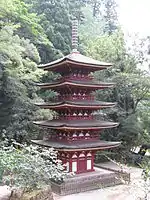 | 34°32′18″N 136°02′25″E | ||
| Tōdai-ji Kanjinsho Repository 東大寺勧進所経庫 Tōdaiji kanjinsho kyōko | 794-929 | Nara | Nara | 34°41′19″N 135°50′14″E | |||
| Tōdai-ji Hokkedō Repository 東大寺法華堂経庫 Tōdaiji Hokkedō kyōko | 794-929 | Nara | Nara | 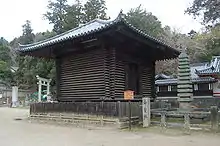 | 34°41′17″N 135°50′39″E | ||
| *Hōryū-ji Kōfūzō 法隆寺綱封蔵 Hōryūji kōfūzō | 794-929 | Ikaruga | Nara | 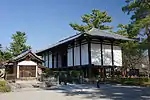 | 34°36′52″N 135°44′08″E | ||
| *Taima-dera West Pagoda 當麻寺西塔 Taimadera saitō | 794-929 | Katsuragi | Nara | 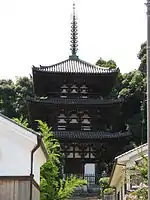 | 34°30′56″N 135°41′40″E | ||
Middle Heian period
Five surviving sites with eight component structures have been designated, all but one of them National Treasures. The Phoenix Hall at Byōdō-in is designated as a single site with four component structures. The five-storey pagoda at Daigo-ji is the earliest structure within the current borders of the city of Kyoto. Both form part of the World Heritage Site Historic Monuments of Ancient Kyoto (Kyoto, Uji and Otsu Cities).[5]
| Structure | Date | Municipality | Prefecture | Comments | Image | Coordinates | Ref. |
|---|---|---|---|---|---|---|---|
| *Daigo-ji Five-Storey Pagoda 醍醐寺五重塔 Daigōji gojūnotō | 952 | Kyoto | Kyoto | 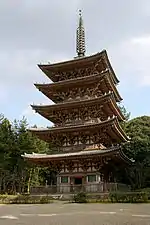 | 34°57′02″N 135°49′20″E | ||
| *Byōdō-in Phoenix Hall (central hall) 平等院鳳凰堂 (中堂) Byōdōin hōōdō (chūdō) | 1053 | Uji | Kyoto | 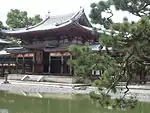 | 34°53′21″N 135°48′28″E | ||
| *Byōdō-in Phoenix Hall (south wing corridor) 平等院鳳凰堂 (両翼廊 (南)) Byōdōin hōōdō (ryōyokurō (minami)) | 1053 | Uji | Kyoto | 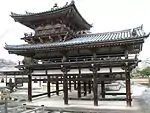 | 34°53′22″N 135°48′28″E | ||
| *Byōdō-in Phoenix Hall (north wing corridor) 平等院鳳凰堂 (両翼廊 (北)) Byōdōin hōōdō (ryōyokurō (kita)) | 1053 | Uji | Kyoto | 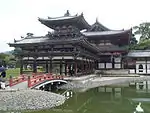 | 34°53′21″N 135°48′28″E | ||
| *Byōdō-in Phoenix Hall (tail corridor) 平等院鳳凰堂 (尾廊) Byōdōin hōōdō (birō) | 1053 | Uji | Kyoto | 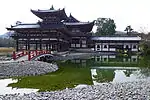 | 34°53′21″N 135°48′27″E | ||
| *Hōryū-ji Belfry 法隆寺鐘楼 Hōryūji shōrō | 1005-1020 | Ikaruga | Nara | 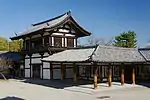 | 34°36′53″N 135°44′04″E | ||
| *Hōryū-ji Large Lecture Hall 法隆寺大講堂 Hōryūji daikōdō | 990 | Ikaruga | Nara | 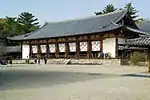 | 34°36′53″N 135°44′03″E | ||
| Thousand Buddha Treasure Tower 多宝千仏石幢 tahō senbutsu sekitō | 1084 | Dazaifu | Fukuoka | at the Kyushu National Museum | 33°31′06″N 130°32′19″E | ||
Late Heian period
Thirty-five surviving sites with thirty-six component structures have been designated, including fourteen National Treasures. The earliest structures, other than four stone tō, outside Nara and Kyoto Prefectures date from the second half of the eleventh century or early twelfth century. Those at Chūson-ji form part of the World Heritage Site Hiraizumi – Temples, Gardens and Archaeological Sites Representing the Buddhist Pure Land.[6] Buraku-ji in Kōchi Prefecture, Shikoku, and Fuki-ji in Ōita Prefecture, Kyushu, contain the earliest wooden structures outside Honshu. The honden of Ujigami Jinja is the earliest wooden Shinto shrine building, while two stone examples from the city of Yamagata are the earliest torii.
| Structure | Date | Municipality | Prefecture | Comments | Image | Coordinates | Ref. |
|---|---|---|---|---|---|---|---|
| Ganjōju-in Hōtō 願成就院宝塔 Ganjōjuin hōtō | 1086-1184 | Hiraizumi | Iwate | 39°00′06″N 141°06′07″E | |||
| Shaku-in Gorintō 釈尊院五輪塔 Shakuin gorintō | 1169 | Hiraizumi | Iwate | 39°00′03″N 141°05′55″E | |||
| *Chūson-ji Konjikidō 中尊寺金色堂 Chūsonji Konjikidō | 1124 | Hiraizumi | Iwate | .jpg.webp) | 39°00′05″N 141°05′59″E | ||
| Chūson-ji Sutra Repository 中尊寺経蔵 Chūsonji kyōzō | 1064-1184 | Hiraizumi | Iwate | 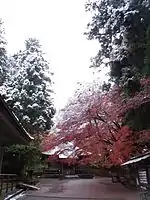 | 39°00′06″N 141°05′58″E | ||
| Kōzō-ji Amidadō 高蔵寺阿弥陀堂 Kōzōji Amidadō | 1177 | Kakuda | Miyagi | 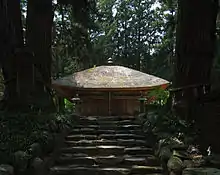 | 38°00′00″N 140°43′06″E | ||
| Torii 鳥居 torii | 1086-1184 | Yamagata | Yamagata | 38°13′43″N 140°19′44″E | |||
| Hachiman Jinja Torii 八幡神社鳥居 Hachiman Jinja torii | 1086-1184 | Yamagata | Yamagata | 38°12′09″N 140°19′14″E | |||
| *Shiramizu Amidadō 八幡神社鳥居 Shiramizu Amidadō | 1160 | Iwaki | Fukushima |  | 37°02′11″N 140°50′14″E | ||
| Gorintō 五輪塔 gorintō | 1181 | Tamakawa | Fukushima | 37°13′45″N 140°24′42″E | |||
| *Ishiyama-dera Hondō 石山寺本堂 Ishiyamadera hondō | 1096 | Ōtsu | Shiga | 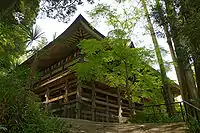 | 34°57′38″N 135°54′20″E | ||
| *Ujigami Jinja Honden 宇治上神社本殿 Ujigami Jinja honden | 1086-1184 | Uji | Kyoto | 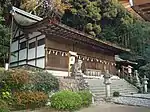 | 34°53′31″N 135°48′41″E | ||
| Ōjõ Gokurakuin Amidadõ 往生極楽院阿弥陀堂 Ōjō Gokurakuin Amidadõ | 1148 | Kyoto | Kyoto | 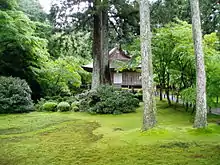 | 35°07′10″N 135°50′05″E | ||
| Tō-ji Treasure House 教王護国寺宝蔵 Kyōōgokokuji hōzō | 1086-1184 | Kyoto | Kyoto |  | 34°58′53″N 135°44′56″E | ||
| Kōryū-ji Lecture Hall 広隆寺講堂 Kõryūji kõdõ | 1165 | Kyoto | Kyoto | 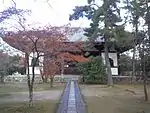 | 35°00′54″N 135°42′23″E | ||
| *Jōruri-ji Three-Storey Pagoda 浄瑠璃寺三重塔 Jōruriji sanjūnotõ | before 1178 | Kyoto | Kyoto | 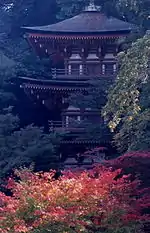 | 34°42′56″N 135°52′25″E | ||
| *Jōruri-ji Hondō 浄瑠璃寺本堂 Jōruriji hondō | 1157 | Kizugawa | Kyoto | 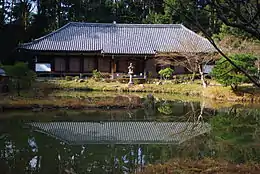 | 34°42′56″N 135°52′22″E | ||
| *Daigo-ji Kondō 醍醐寺金堂 Daigoji kondō | 1086-1184 | Kyoto | Kyoto | 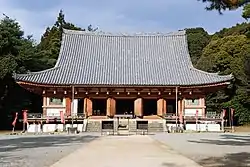 | 34°57′05″N 135°49′18″E | ||
| *Daigo-ji Yakushidō 醍醐寺薬師堂 Daigoji Yakushidō | 1121 | Kyoto | Kyoto | 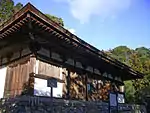 | 34°56′44″N 135°50′19″E | ||
| Kongō-ji Tahōtō 金剛寺多宝塔 Kongōji tahōtō | 1086-1184 | Kawachinagano | Osaka | 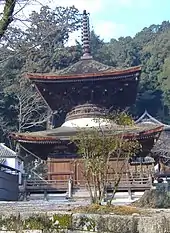 | 34°25′42″N 135°31′46″E | ||
| *Ichijō-ji Three-Storey Pagoda 一乗寺三重塔 Kongōji tahōtō | 1171 | Kasai | Hyōgo |  | 34°51′32″N 134°49′08″E | ||
| Kakurin-ji Jōgyōdō 鶴林寺常行堂 Kakurinji jōgyōdō | 1086-1184 | Kakogawa | Hyōgo | 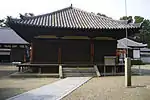 | 34°45′08″N 134°49′56″E | ||
| *Kakurin-ji Taishidō 鶴林寺太子堂 Kakurinji Taishidō | 1112 | Kakogawa | Hyōgo | 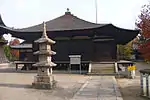 | 34°45′08″N 134°49′58″E | ||
| Omiashi Jinja Stone Tōba 於美阿志神社石塔婆 Omiashi Jinja ishi tōba | 1086-1184 | Asuka | Nara | 34°27′24″N 135°48′11″E | |||
| Former Fuki-ji Rakandō 旧富貴寺羅漢堂 Fuki-ji Rakandō | 1086-1184 | Ikaruga | Nara | dismantled, consolidated by the National Research Institute for Cultural Properties, Tokyo, and re-erected in the precincts of Hōryū-ji | 34°36′50″N 135°44′16″E | ||
| Gorintō 五輪塔 gorintō | 1086-1184 | Katsuragi | Nara | 34°31′09″N 135°41′43″E | |||
| Murō-ji Nōkyōtō 室生寺納経塔 Murōji nōkyōtō | 1086-1184 | Uda | Nara | 34°32′18″N 136°02′22″E | |||
| Hōryū-ji Tsumamuro 法隆寺妻室 Hōryūji tsumamuro | 1121 | Ikaruga | Nara | 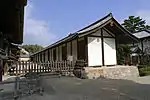 | 34°36′52″N 135°44′07″E | ||
| Butsuryū-ji Stone Chamber 仏隆寺石室 Butsuryūji sekishitsu | 1086-1184 | Uda | Nara | 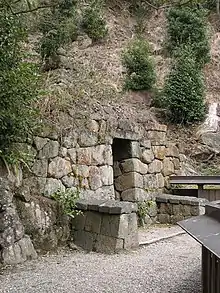 | 34°30′56″N 136°00′35″E | ||
| Eizan-ji Seven-Storey Pagoda 榮山寺七重塔 Eizanji shijijūnotō | 1086-1184 | Gojō | Nara | 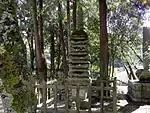 | 34°21′21″N 135°43′13″E | ||
| *Taima-dera Hondō (Mandala-dō) 當麻寺本堂(曼荼羅堂) Taimadera hondō (mandala-dō) | 1161 | Katsuragi | Nara | 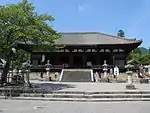 | 34°30′58″N 135°41′41″E | ||
| *Sanbutsu-ji Oku-no-in (Nageire-dō) 三仏寺奥院(投入堂) Sanbutsuji oku-no-in (nageire-dō) | 1086-1184 | Misasa | Tottori | 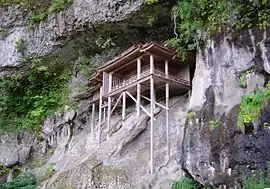 | 35°23′47″N 133°57′34″E | ||
| Getsurin-ji Yakushidō 月輪寺薬師堂 Getsurinji Yakushidō | 1086-1184 | Yamaguchi | Yamaguchi | 34°08′36″N 131°43′15″E | |||
| *Buraku-ji Yakushidō 豊楽寺薬師堂 Burakuji Yakushidō | 1151 | Ōtoyo | Kōchi | 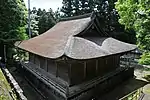 | 33°47′32″N 133°43′38″E | ||
| Gorintō 五輪塔 gorintō | 1170 | Usuki | Ōita | 33°05′23″N 131°45′43″E | |||
| Gorintō 五輪塔 gorintō | 1172 | Usuki | Ōita | 33°05′23″N 131°45′43″E | |||
| *Fuki-ji Ōdō 富貴寺大堂 Fukiji Ōdō | 1086-1184 | Bungotakada | Ōita | 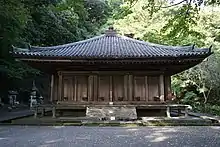 | 33°32′16″N 131°31′43″E |
See also
| Wikimedia Commons has media related to Architecture of Heian period. |
References
- "Cultural Properties for Future Generations" (PDF). Agency for Cultural Affairs. March 2013. Archived from the original (PDF) on 23 September 2013. Retrieved 4 May 2014.
- "Database of National Cultural Properties: 国宝・重要文化財 (建造物): 平安" (in Japanese). Agency for Cultural Affairs. Archived from the original on 4 December 2015. Retrieved 4 May 2014.
- "Historic Monuments of Ancient Nara". UNESCO. Retrieved 4 May 2014.
- "Buddhist Monuments in the Horyu-ji Area". UNESCO. Retrieved 4 May 2014.
- "Historic Monuments of Ancient Kyoto (Kyoto, Uji and Otsu Cities)". UNESCO. Retrieved 4 May 2014.
- "Hiraizumi – Temples, Gardens and Archaeological Sites Representing the Buddhist Pure Land". UNESCO. Retrieved 4 May 2014.